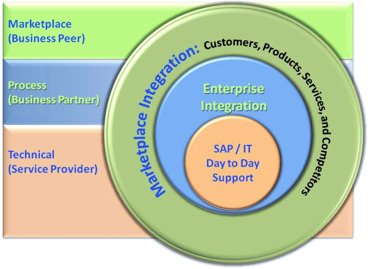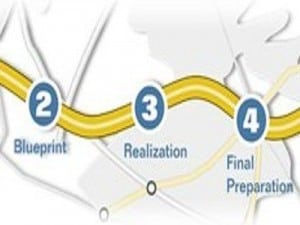One key pillar of moving Beyond Technology Alignment requires Organizational Change Management Inside the SAP IT Support Organization (OCM inside IT). A key component of that OCM within IT relies heavily on Creating a Knowledge Centered Learning Organization. Within that learning organization, especially with enterprise applications such as SAP, you need to build organizational maturity. A three-tier approach to building that organizational maturity is part of the Series on SAP Competency Center or SAP Center of Excellence.
The SAP IT Organization Challenge
Being an “IT Organization” is where the challenge for change begins. IT has been so focused on delivering technical solutions that they missed business integration along the way. Adding to this is the youth of IT as a business discipline. Think about it: People have been doing business for thousands of years. Technology, bits, bytes, interconnected systems, data transmissions, and information age knowledge workers are a new phenomenon within the last few decades.
Because of this, we need to know how to quickly mature the SAP or IT organization from simple service provider, to business partner, to business peer. This requires far more than the traditional domain and technology management in so many IT organizations today. Ultimately, the problem comes down to SAP Service Delivery versus Value Delivery.
The Answer: Develop Organizational Maturity
For SAP-Enabled Business Transformation for IT Leadership, we started with CIO Magazine’s CIO Maturity Model and applied it to the IT delivery organization. The delivery organization maturity model consists of three key levels of organizational maturity: internal, enterprise, and external focus. The concentric circles below provide a visual of this concept. When considering SAP Service Delivery versus Value Delivery, you must understand how to develop that maturity. The service delivery domain is technical in nature, and the value delivery domain is focused on enabling business. The value domain is related to customers, marketplace, and improved products or services.
SAP IT Organization Maturity: Growing Pains
Each of the tasks within these three concentric circles requires a particular delivery competence. This delivery competence roughly equates to the skills and experience needed to address each of the key business support areas. You will also face “growing pains” within each of these maturity stages:
- Plan
- Execute
- Adjust and stabilize
- Transition part of the organization to the next maturity level
This is a hierarchical maturity model. While the diagram I use shows the concentric circles, they should be thought of as circles of influence, skill development, and promotion. Not everyone will move from the Internal Support area to the Enterprise Integration domain. Likewise, not everyone will move from Enterprise Integration to Marketplace Development. The SAP or IT employee should consider these as key career milestones.
For insight on How To Navigate the SAP Business Transformation Journey, you need to rethink the SAP IT organization’s role in the enterprise. Are you satisfied with being just a service provider? Or do you want to do more? To make the transition, you need to evaluate the constraints and then do what is necessary to remove them.
Dealing with SAP IT Organizational Constraints
Whether those constraints are time, resources (budget, technical infrastructure, etc.), or people, you should do a SWOT analysis (Strengths, Weaknesses, Opportunities, and Threats) of each area as you engage.
Additionally, if you have a relatively small SAP or IT support organization, then the Level 1 and Level 2 maturity areas can be merged and use less extensive development efforts.
The Three-Part SAP Organization Change
The first two levels of the maturity model involve SAP Service Delivery versus Value Delivery. The second and third levels are about SAP IT Convergence Beyond Business to IT Alignment.
The three maturity areas are the following:
- Technical service delivery
- Cost and process value delivery
- Customer and marketplace integration
As senior IT leaders everywhere struggle with growing budget pressures, you must focus more aggressively on business value now more than ever. To do so, you need Organizational Change Management Inside the SAP IT Support Organization with a strong focus on Creating a Knowledge Centered Learning Organization. By developing both the infrastructure to support a learning organization, as well as the mentoring, coaching, and development, you will be well on your way to transforming your IT efforts and move toward becoming a business partner.
My next post will evaluate the specific maturity and development details for each stage in creating a genuine IT Converged SAP Center of Excellence.







